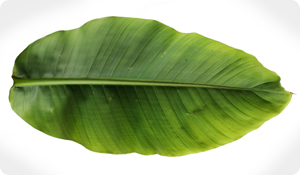
You probably enjoy a few bananas or more every week; this inexpensive fruit is tasty and easy to find. But did you know that many people also make good use of the banana leaf? Banana leaves are the big, inedible fronds on the banana plant that appear above ground, and can be used for a variety of cooking and first-aid needs.
"Banana leaf is generally used among various Latino, Indian, and Asian cultures in the United States but is gaining popularity among a broader population base," explains Phyllis D. Light, MA, herbalist with the Appalachian Center for Natural Health in Alabama.
Common Banana Leaf Uses
While you can't eat banana leaves, you can do almost anything else with them. Just remember to "Make sure you clean the banana leaf before using it. And lightly steam the leaf if it is too stiff," Light says. She recommends you use banana leaves in
1. Cooking
Line your pans and other cookware with banana leaves to prevent the food from sticking. It's a good alternative to butter, oil, and non-stick sprays, and makes clean up easier. You can also wrap or nest your food inside the leaves (secure the leaves around the food with kitchen string or toothpicks) when you cook, steam, or grill. Wrapping food in banana leaves can help lock in flavor and increase tenderness, and, unlike tin foil, banana leaves add a unique and appetizing aroma. Be sure to place the wrapped food in a pan or baking dish, since juices can drip through the leaves.
2. Serving Food
Use banana leaves instead of a plate or a platter to serve your food. Leaves are flexible but firm, and make for a colorful, exotic presentation. Best of all, after the meal, you can throw the leaves away, and skip the dishes!
3. Storing Food
Banana leaves can replace plastic wrap, protecting food when you put it away. Some experts recommend placing a damp towel over the leaves to keep them moist. In the refrigerator, the uncooked leaves should last for up to two days.
4. Healing
Banana leaves are anti-fungal and help prevent infection. The leaves can be used fresh, or you can infuse them into oil and use for insect bites, rashes, skin irritations, spider bites, and bee stings. Banana leaves contain allantoin, a chemical compound which speeds the healing of wounds and abrasions. Banana leaves can also be used to make a wash for the skin, and can help soothe acne, eczema, and sunburn.
Where to Find Banana Leaves
You can buy banana leaves in many ethnic markets and specialty grocery stores, where they're usually found fresh in the produce aisle or frozen in the freezer section. You can also buy banana leaves from one of many online retailers, and have them shipped right to your door. The cost is usually just a few dollars for a pack of several leaves, and, as Light points out, the multiple uses you can get from them can really pay off.
Phyllis D. Light, MA, reviewed this article.
Source:
Sampath Kumar, et al. "Traditional and Medicinal Uses of Banana." Journal of Pharmacognosy and Phytochemistry 2012; 1(3):51-63. Accessed online Aug. 18, 2013.
http://www.phytojournal.com/vol1Issue3/Issue_sept_2012/9.1.pdf





